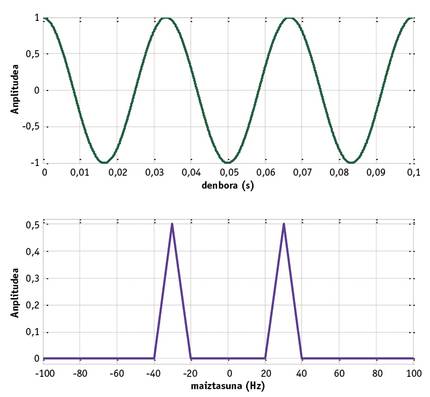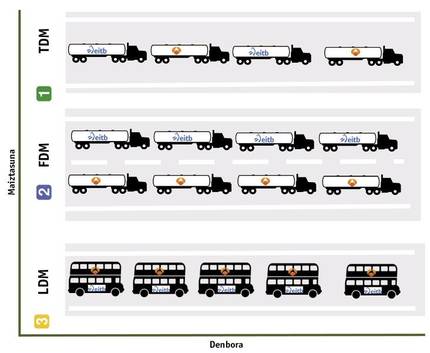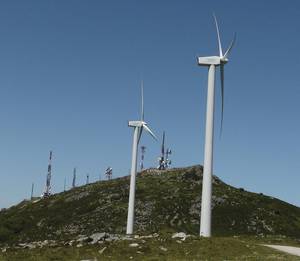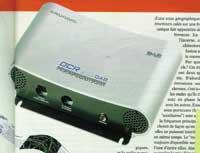LDM: New technology for the survival of Digital Terrestrial Television by UPV
2015/12/01 Montalban Sanchez, Jon - TSR ikerketa-taldea EHUko Ingeniaritza Goi Eskola Teknikoa Iturria: Elhuyar aldizkaria

Invisible airway: electromagnetic spectrum and jams
We are the information society. At this time we are surrounded at all times by thousands of radio waves that transport the flow of essential information from one side to the other, despite being invisible to human sight. To give an order to this chaos, all wireless communications are organized according to the regulations established by public bodies, and each is assigned, among other things, a range of radio spectrum.
Simply put, electromagnetic waves are an invisible means of transport that transports daily information to our mobile phones or TV antennas, which spread through space and contain perpendicular electrical and magnetic components. To understand by example, the propagation of waves is very similar to that of the sea waves that we can observe on the coast, but instead of being water, the medium is air. In addition to the amplitude and wavelength, the frequency is the magnitude of the radio waves. In short, the frequency or frequency of a wave indicates the number of times the same wave repeats itself in the second, so in addition to having a free time to transmit any electromagnetic wave, the corresponding frequency group should be free of interference. The graphical explanation of this phenomenon can be seen in Figure 2.
Thus, in cold, although we may be surprised, in the day to day we often find ourselves with this concept of frequency. Who does not have in mind, for example, the frequency of your favorite radio when tuning in to your favorite program (100.1 MHz, for example)? Or who has not had to resynchronize the television signal in recent years or months? In essence, the key to this question lies in the spectral arrangement of signals.
Likewise, knowledge of this characteristic of waves, frequency, has become an indispensable tool for the development of new generation technologies. This feature allows, for example, to broadcast several television programs simultaneously (during the same time) from a single antenna, adapting to each part of the frequency spectrum.
Let's take a practical example: wireless transmission can be assimilated to the current transport system (see figure 3). Suppose the different sources of information, represented in the image as trucks, must travel from Bilbao (antenna) to Donostia (receiver). First option (in case 1: TDM (Time Division Multiplexing), can be sent through a single lane national road (for example, by the coastal route), assigning each one a certain time, placing each truck successively. It is clear that this solution is not very effective because of the possibility of generating large jams that can cushion the “flow of information”. What is the solution? One option would be to use the same space to use the frequency of each truck or information signal and place the flow of information in different lanes (parts of the spectrum). Thus, the single-lane road has become a multi-lane highway, increasing the capacity of the road (case 2: FDM). If we search in technical books we can see that behind this phenomenon is Frequency Division Multiplexing (FDM) or Frequency Multiplexing. It is a very used technique, among other things because the television signals we receive daily at home are organized like this.
New LDM multiplexing system: no more jams
In the new LDM multiplexing system developed at the UPV-EHU (in collaboration with the Communication Research Centre of Canada and the Electronics and Telecommunications Research Institute of Korea), it is distributed over the allotted time and taking full advantage of the frequency rather than sharing the transmitted power, frequency or time. The operation is simple: information flows are placed above each other and each is assigned a power range. This structure allows emitters to use 100 percent of the available means for signal transmission, both in the temporal and frequency fields. Let us see more clearly the example of transport. The LDM technique proposes the use of two or three storey vehicles to increase efficiency, that is, trucks that, instead of carrying conventional trucks, would carry cars, or normal buses, two-storey buses that would double the capacity to transport information with the same space (case 3).
This technology will be essential for future DTT. In fact, regarding the use of the radio spectrum, in recent years there has been the largest debate among all the media about the allocation of the frequency range that digital television has. According to many experts, television does not efficiently manage the resources allocated to it, so the organizations in charge of the spectrum have received a series of proposals to offer the frequency intervals that have become free as a result of the digitization of television to other more efficient services such as mobile telephony.
In addition, they accuse the first generation of digital television, DTT, of their inability to offer mobile services. This problem is very critical as, according to the latest studies, mobile data traffic will increase eleven times between 2015 and 2018, and at the end of this period, two-thirds of total traffic will adapt to video streaming. Therefore, for the radio systems of the coming generations it will be indispensable condition that they can be seen anywhere through mobile TV receivers in high definition.
Among the technologies that can address these problems, experts are looking with good eyes at LDM. In addition to being a more efficient system, it is a solution fully compatible with current technology and, in fact, only a few changes in existing technology would be necessary. It should also be noted that this efficiency allows offering more resources to mobile services, so this multiplexing system would double or triple the coverage of mobile services compared to conventional multiplexing systems.
Thus, the technical team of the new ATSC 3.0 Digital Terrestrial Television Standard in North America has opted for LDM technology as a technological solution for its next generation of television. Thus, it is possible that in the future, among others, most television receivers that will be sold in North America and South Korea have an implementation of this technology developed by the University of the Basque Country along with other groups.
Contributions from the UPV/EHU TSR Group on LDC
The Signal Treatment and Radiocommunication Group of the UPV-EHU (TSR), led by professors Manuel Velez Elordi and Pablo Angueira, was at the beginning of the LDM, so it collaborated closely with the groups that were going to develop the idea from the beginning. Moreover, the first theoretical-practical developments of this new multiplexing system were led by the TSR group, as the key algorithms for receiver design were developed within the doctoral thesis defended by Jon Montalban Sanchez at the UPV. The algorithms developed in the TSR group developed mechanisms to differentiate the sources of information sent in each frequency channel or bus. Despite not proposing a complete system, it proposes a concrete technology that can give a direct solution to the two great challenges that DTT will have to face in the near future, that is, a new multiplexing system that guarantees the efficient use of the aforementioned radio spectrum and the offer of mobile services.
Finally, it should be noted that several theoretical and practical studies have been carried out in the TSR group to demonstrate the usefulness of this proposal. It should be noted that the first LDM receptor developed worldwide has been used. Subsequently, this recipient has transferred the name of the University of the Basque Country to various international exhibitions to show the benefits of the LDM, including the NABSHOW of Las Vegas in 2015, which brings together more than 100,000 professionals in the sector. In addition, publications based on the aforementioned thesis obtained the award for the best contribution at the IEEE Broadband Multimedia Systems and Broadcasting international congresses held in 2014 in Beijing (China) and 2015 in Ghent (Belgium).
Bibliography

Gai honi buruzko eduki gehiago
Elhuyarrek garatutako teknologia








